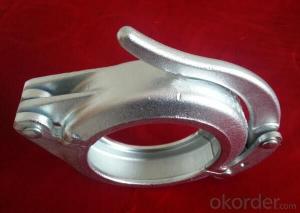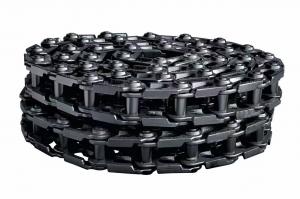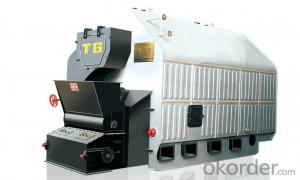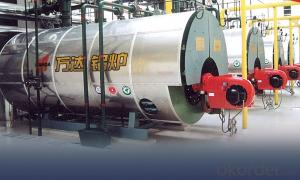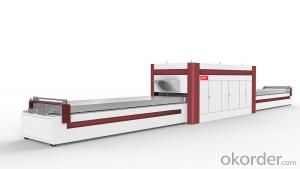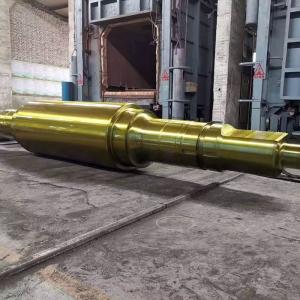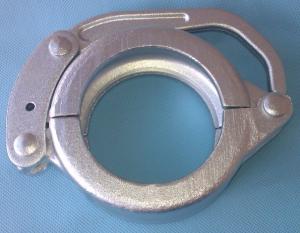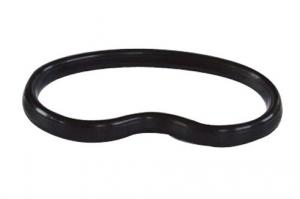Concrete Pump Clamp Coupling DN100 Forged
- Loading Port:
- China main port
- Payment Terms:
- TT OR LC
- Min Order Qty:
- 50 PCS
- Supply Capability:
- 10000 PCS/month
OKorder Service Pledge
OKorder Financial Service
You Might Also Like
Product Description:
A coupling is a device used to connect two delivery pieps together at their ends for the purpose of transmitting, and prevent the concrete from leaking. Couplings do not normally allow disconnection of shafts during operation.
Main Product Features:
1. Use high quality steel. After high-temperature 1200 forging,it’s shaped.
2.High temperature forging.
3.convenient to use, easy operation,and high safety.
4.good sealing,wear-resising,longer service life.
5.do not restrict the steering tubes, pipes during the working process can be 360 degrees rotation.
6.used in concrete pump truck,concrete pump and pipeline connection seal in construction
work equipment.
Product Specifications:
1.Forged
2.2--8 inch
3.Galvanizing/Baking varnish
4.More durable,light,beautiful
Production steps:
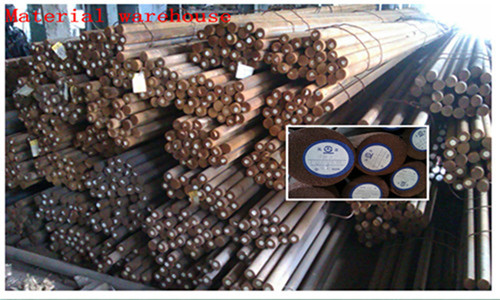

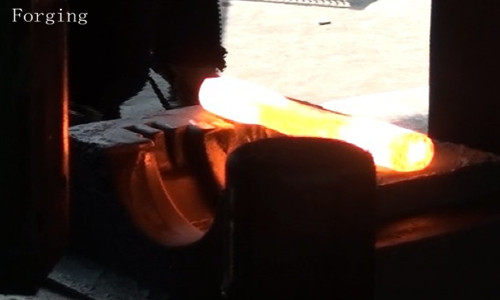
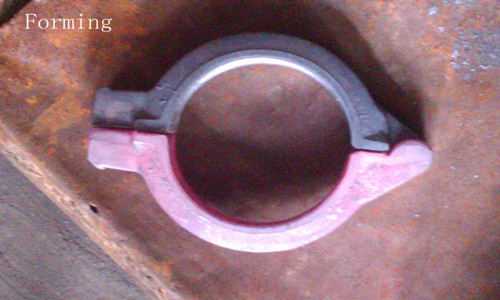

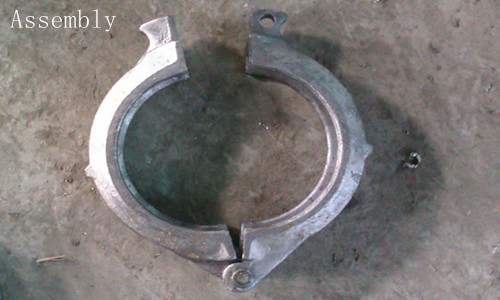
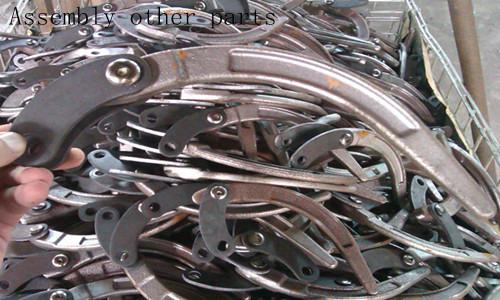
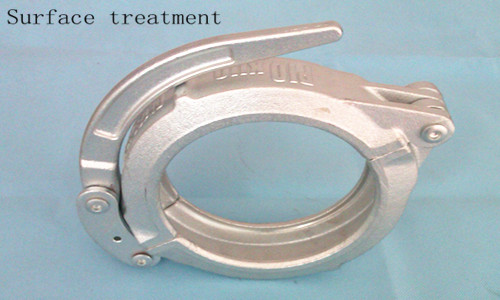
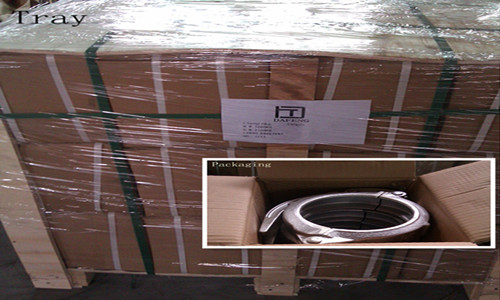
Concrete pump clamp Catalogue
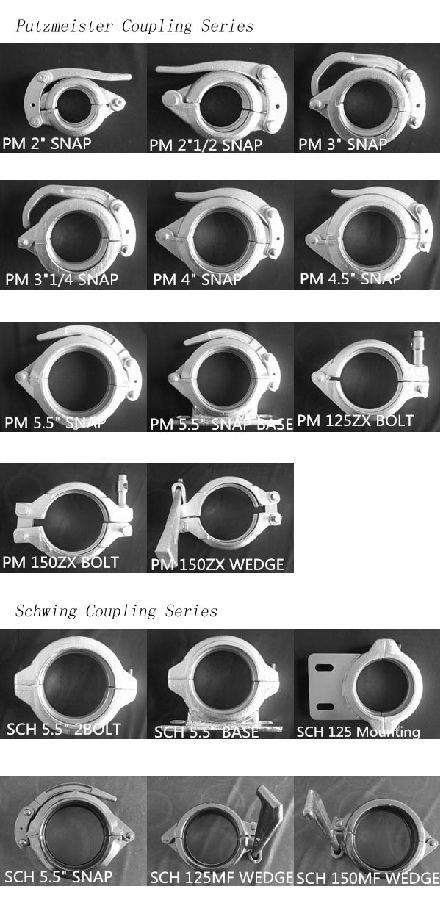
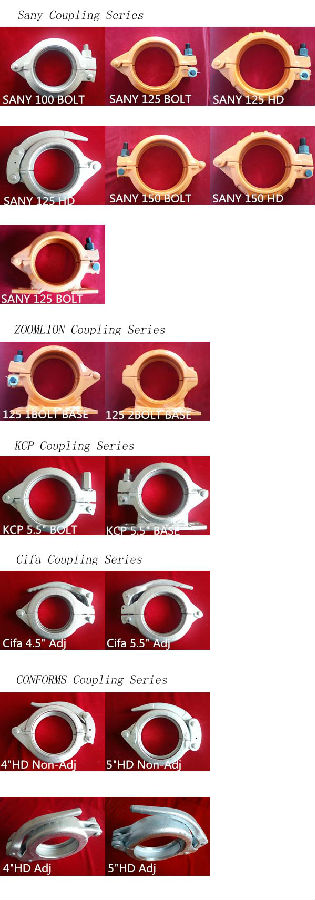
FAQ
1.How do you regarding your product quality?
As our principle is more safety to save more. In China, there are lots of manufactures of this line, but we are the first one that use the forging technic in producing, firmly meet the PM standard.
2.Can I get some samples?
Of course you can. Small sample for free, but you pay the express. For some products are not small, like concrete pump pipe, it’s very difficult to deliver one pipe of 3000mm. If it’s possible, we’d like that you can come here to visit our factory. Welcome!
3. I want to make our logo on the products, is that ok?
Yes, it’s totally ok. OME is available from us.What you should do is send your logo, brand name, or picture to us. And let other things leave on us.
- Q:How is a concrete pump pipe different from a regular pipe?
- A concrete pump pipe is specifically designed to be used in concrete pumping applications, whereas a regular pipe is more commonly used for general plumbing purposes. Concrete pump pipes are typically made of high-quality and durable materials to withstand the high pressure and abrasive nature of pumped concrete. They also have specialized ends, such as flanges or couplings, to provide a secure connection between the pump and the delivery system. In contrast, regular pipes may come in various materials and sizes, depending on their intended use in plumbing systems.
- Q:How can a faulty battery affect the operation of the pump?
- The operation of a pump can be significantly affected by a faulty battery. Firstly, inadequate power supply from a faulty battery can lead to slow or weak pumping action. This can result in the pump's inability to generate the required pressure or flow rate, causing inefficient or ineffective operation. Moreover, intermittent power supply caused by a faulty battery can cause inconsistent pumping action, with the pump starting and stopping unpredictably. These interruptions can create inefficiencies, diminish the pump's performance, and potentially harm the equipment or system being operated. Furthermore, a faulty battery may have a limited charge retention capacity. This can restrict the pump's operating time, necessitating frequent recharging or battery replacement. In situations where continuous or prolonged pump usage is necessary, a faulty battery can disrupt operations, resulting in downtime and reduced productivity. Additionally, the overall lifespan of the pump can be affected by a faulty battery. If the battery fails to consistently provide the required power, the pump may experience strain or excessive wear, potentially shortening its operational life. In conclusion, a faulty battery can have numerous unfavorable effects on the operation of a pump, including reduced performance, inconsistent pumping action, limited operating time, potential damage, and decreased equipment lifespan. It is crucial to conduct regular maintenance and promptly replace faulty batteries to ensure optimum pump performance and longevity.
- Q:What are the different types of concrete pump hopper cylinders?
- There are primarily two types of concrete pump hopper cylinders: single-acting cylinders and double-acting cylinders. Single-acting cylinders have only one piston that pushes the concrete out of the hopper. On the other hand, double-acting cylinders have two pistons, one for pushing the concrete out and the other for bringing it back into the hopper.
- Q:What are the indications of a faulty concrete pump hydraulic motor?
- There are several indications that can point to a faulty concrete pump hydraulic motor. Some common signs to look out for include: 1. Loss of power: If the hydraulic motor is not functioning properly, you may notice a significant loss of power in the concrete pump. The motor may struggle to generate enough force to pump the concrete effectively, resulting in slower or weaker output. 2. Excessive noise or vibrations: A faulty hydraulic motor may produce unusual noises or vibrations during operation. This could be a result of damaged internal components or misalignment, indicating a problem with the motor. 3. Fluid leaks: Hydraulic motors rely on the proper flow and pressure of hydraulic fluid to function correctly. If you notice any fluid leaks around the hydraulic motor or its associated components, it could be a sign of a faulty motor that needs attention. 4. Overheating: When a hydraulic motor is faulty, it may overheat due to increased friction or internal malfunctions. If you notice excessive heat coming from the motor or associated components, it is essential to address the issue promptly to avoid further damage. 5. Inconsistent or jerky movement: A faulty hydraulic motor may cause the concrete pump to operate inconsistently or jerkily. This can result in uneven pouring or difficulty in controlling the flow of concrete, indicating a problem with the motor's performance. 6. Increased energy consumption: If the hydraulic motor is faulty, it may require more energy to operate properly. This can lead to a noticeable increase in energy consumption, which can be observed through higher electricity bills or a greater strain on other parts of the pump's system. It is important to note that these indications may vary depending on the specific make and model of the concrete pump hydraulic motor. It is always recommended to consult the manufacturer's guidelines or seek professional assistance to diagnose and address any issues with the hydraulic motor effectively.
- Q:Can concrete pump spare parts be recycled or disposed of responsibly?
- Yes, concrete pump spare parts can be recycled or disposed of responsibly. Many of the components used in concrete pump spare parts are made of materials such as steel, iron, and rubber, which can be recycled. These materials can be separated and sent to recycling facilities where they can be processed and reused in the manufacturing of new products. Additionally, responsible disposal methods can also be utilized for concrete pump spare parts that cannot be recycled. This includes ensuring that they are disposed of in designated waste management facilities, where they can be properly treated and managed. By recycling or disposing of concrete pump spare parts responsibly, we can minimize the environmental impact associated with their production and disposal. It is essential to follow proper recycling and waste management practices to ensure a sustainable approach towards the lifecycle of these spare parts.
- Q:Are there any specific training or certifications required for handling and installing concrete pump spare parts?
- Yes, there are specific training and certifications required for handling and installing concrete pump spare parts. Due to the specialized nature of the equipment and the potential risks involved, individuals who handle and install concrete pump spare parts should undergo proper training and obtain relevant certifications. Firstly, it is essential to have a thorough understanding of the functioning and components of concrete pumps. This knowledge can be acquired through comprehensive training programs offered by equipment manufacturers, industry associations, and vocational schools. These training programs cover topics such as pump operation, maintenance, troubleshooting, and safety protocols. Additionally, specific certifications may be required depending on the jurisdiction or industry standards. For example, the American Concrete Pumping Association (ACPA) offers a certification program known as the ACPA Operator Certification. This certification requires individuals to demonstrate their knowledge and skills related to concrete pumping equipment, including the handling and installation of spare parts. Obtaining these certifications ensures that individuals are equipped with the necessary knowledge and skills to handle and install concrete pump spare parts safely and efficiently. It also helps in maintaining compliance with industry regulations and standards. It is important to note that the specific training and certification requirements may vary depending on the region, industry, and the type of concrete pump being used. Therefore, it is recommended to consult local regulations and industry guidelines to ensure compliance with the necessary training and certification requirements for handling and installing concrete pump spare parts.
- Q:How does a concrete pump piston work?
- By creating a back-and-forth movement, the concrete pump piston propels the concrete through the pump and into the desired location. The piston is a cylindrical part that fits snugly inside a cylinder and is connected to a rod, which is linked to a hydraulic system. When the hydraulic system is activated, it propels the rod forward, thereby causing the piston to move in the same direction. As the piston advances, it creates a vacuum behind it, which draws the concrete into the cylinder through an inlet valve. Once the piston reaches the end of its forward stroke, the hydraulic system changes its direction, retracting the rod and causing the piston to move backward. Consequently, this action closes the inlet valve and opens an outlet valve, enabling the concrete to be forced out of the cylinder and into the delivery line. The reciprocating motion of the piston, combined with the alternating opening and closing of the inlet and outlet valves, facilitates a continuous flow of concrete through the pump. This process is rapidly repeated, ensuring efficient and consistent pumping of concrete to the desired location.
- Q:How can one determine the correct weight and balance requirements for concrete pump spare parts?
- To ascertain the appropriate weight and balance specifications for concrete pump spare parts, several factors must be taken into account. First and foremost, consulting the manufacturer's specifications and guidelines specific to the concrete pump model is of utmost importance. These documents typically contain comprehensive information regarding the weight and balance requirements for each spare part. Secondly, it is essential to comprehend the function and purpose of each spare part. Different components vary in weight and can significantly impact the overall balance of the pump. For example, larger elements like booms or outriggers may necessitate precise weight distribution to ensure operational stability. Moreover, considering the intended usage and environmental conditions of the concrete pump is imperative. If the pump is expected to operate in challenging terrains or extreme weather, additional weight might be necessary to enhance stability. In addition to the manufacturer's guidelines, seeking counsel from experts or engineers knowledgeable about concrete pumps can provide invaluable insights. These professionals can analyze the specific requirements of the pump and offer guidance on the appropriate weight and balance specifications for the spare parts. Lastly, conducting thorough testing and inspections after installing any spare parts is crucial. This ensures compliance with the weight and balance requirements and allows for any necessary adjustments to be made. In conclusion, determining the correct weight and balance requirements for concrete pump spare parts necessitates a combination of understanding manufacturer guidelines, considering the purpose and conditions of the pump, seeking expert advice, and performing comprehensive testing and inspections.
- Q:What is the purpose of a concrete pump electric motor?
- The concrete pump electric motor serves the purpose of supplying the necessary power and energy to operate the concrete pump. By converting electrical energy into mechanical energy, the motor propels the hydraulic system of the pump. This hydraulic system is accountable for drawing in concrete from the hopper and propelling it through the pipes to the intended destination. Through its smooth and efficient operation, the electric motor guarantees precise placement of the concrete and enhances productivity at construction sites. Moreover, the utilization of an electric motor eradicates the requirement for manual labor and minimizes emissions in contrast to conventional diesel-powered pumps, thereby presenting a more environmentally conscious alternative.
- Q:What are the indications of a clogged or damaged concrete pump filter?
- The indications of a clogged or damaged concrete pump filter can include decreased flow rate, loss of pressure, irregular or uneven concrete distribution, increased wear and tear on the pump system, and potential blockages or breakdowns in the pump.
1. Manufacturer Overview |
|
|---|---|
| Location | |
| Year Established | |
| Annual Output Value | |
| Main Markets | |
| Company Certifications | |
2. Manufacturer Certificates |
|
|---|---|
| a) Certification Name | |
| Range | |
| Reference | |
| Validity Period | |
3. Manufacturer Capability |
|
|---|---|
| a)Trade Capacity | |
| Nearest Port | |
| Export Percentage | |
| No.of Employees in Trade Department | |
| Language Spoken: | |
| b)Factory Information | |
| Factory Size: | |
| No. of Production Lines | |
| Contract Manufacturing | |
| Product Price Range | |
Send your message to us
Concrete Pump Clamp Coupling DN100 Forged
- Loading Port:
- China main port
- Payment Terms:
- TT OR LC
- Min Order Qty:
- 50 PCS
- Supply Capability:
- 10000 PCS/month
OKorder Service Pledge
OKorder Financial Service
Similar products
New products
Hot products
Related keywords
